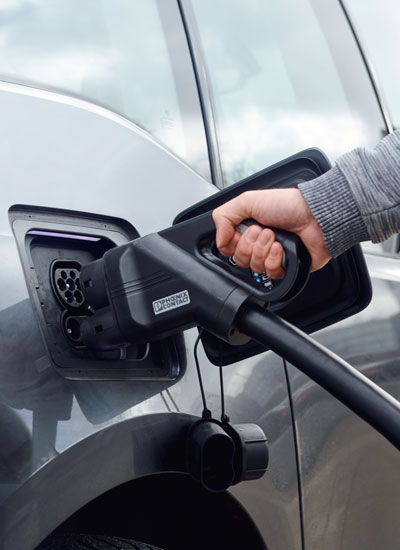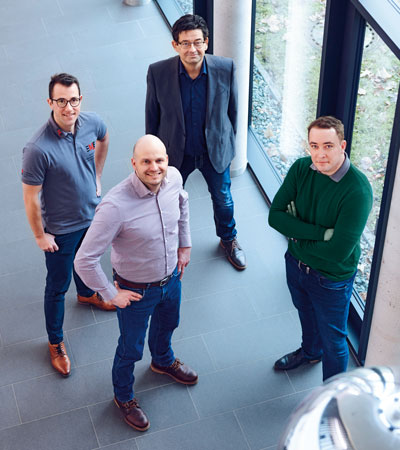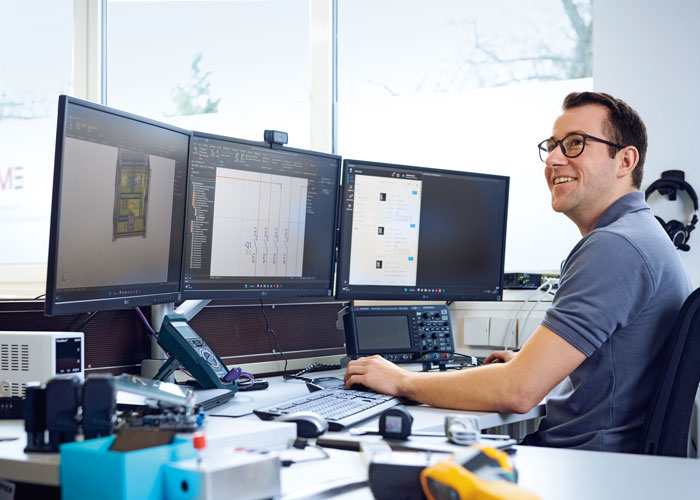Text Stephan Kuhn ––– Photography
Professor Tiedemann, the energy revolution is advancing faster than anticipated, and the energy mix is changing. Companies have to be prepared for this, too. What is the current situation?
Roland Tiedemann: There is a general problem we face when it comes to the energy revolution – storing the energy. There has been too little attention given to this core issue so far. The country is virtually covered in wind and solar farms, and yet there’s a limit to what we can do. There is still a long way to go. In our research project, we therefore always view the energy revolution in parallel with the subject of electromobility.
Why is that?
Tiedemann: Electromobility is important for two reasons – firstly, as a consumer, and secondly, as a means of storage. At the moment, we can’t even provide the energy that would be necessary for a wholesale switchover to electromobility – our electricity grids simply don’t have that kind of capacity. The other key aspect is that electric vehicles can also act as a means of storage, but we are still a long way from where we need to be.
So much depends on storage technology, then ...
Clemens Kerssen: Absolutely. That is what we are focusing on here in the Department for Electromobility and Power Electronics. To our mind, when we think about electromobility, we are also looking at the storage technology. Our energy supply used to be centralised, but is now increasingly decentralised – for example with wind farms, solar panels, biogas, etc. – and the same applies to consumers. The interplay between electromobility, charging technology and decentralised energy supply and energy storage is therefore a core question for the energy revolution.
Who exactly is still running behind?
Kerssen: To put it simply – everyone. We’re all doing something somewhere, but we’re missing the big picture. We have issues on the technology side, in standardisation, in legislation and in availability. There are a huge number of questions that are yet to be fully addressed. What’s more, many companies are doing their own thing to bring their own, manufacturer- specific solutions onto the market. From our perspective, this is counterproductive and not conducive to the global energy and mobility revolution. We have really felt the weaknesses of the system for ourselves for the first time as a result of the Ukraine war. Storage should actually have been factored into the energy revolution from the outset. After all, it’s always been known that we will have to switch from continuous generation based on power plants, for instance, to sporadic generation based on wind farms and solar installations, for example. We have to create load distribution – and that means storage.
What is the specific question you are pursuing in your research project?
Kerssen: We were interested in how it might be possible to build high-performance rapid charging technology for electric vehicles, because combustion engines still have that key advantage of only taking minutes to fill up. We also realised that, to achieve high charging capacity, we would need intermediate storage in our electricity grid, too. Otherwise, the grid will be overloaded in the evenings when everyone is charging their cars. That’s how our Power 400 research project got started, which led us to develop high-performance rapid charging systems with integrated buffer storage.
And what does your current solution look like?
Tiedemann: We have produced the prototype for a DC rapid charging station, and can theoretically charge with one Megawatt at a single charging point. That puts us ahead of the pack at European level. By way of comparison, one Megawatt is what they use to charge submarines in Kiel. Our AC technology is based on a modular concept. We have a master-slave system, in which a single master can be used to control and easily retrofit various different slave units. As a result, we don’t have to implement a complete standard plan immediately, but instead can wait and see how well used the charging park is. Our systems are already designed for buffer storage. We are currently using electrical battery storage, but we are also working on a combination with fuel cell technology.
How much of your work, or that of TH Lübeck, has gone into this development?
Kerssen: Everything – and much, much more (he laughs). As we tell our students, this project covers everything you will learn when studying electrical engineering or IT. We build the hardware, we program the software, and we take on the circuit board manufacturing if there isn’t a standard circuit board available. Our system has an interface to the battery management system, features an energy management system, and is ready to interface with the grid and communicate with the battery or fuel cells. We have integrated everything from the payment system to the grid connection, and could even implement bidirectionality – so as far as we’re concerned, we’re good to go.
So at the end of the project, there will be a charging station with your name on it?
Tiedemann: Not necessarily. What’s important is that we have a product that can meet the current challenge and that we are as open as possible to various perspectives. Let’s get that launched first and see how the field reacts and how it goes down. Some energy companies want to provide a nationwide charging infrastructure and the foundations of this have already been laid, more or less, but without doing any location analyses. That’s a big gap.
Who will benefit from your wealth of knowledge?
Tiedemann: We are at the prototype stage, and now we have to find industry partners to launch the product onto the market. With the experience we have gained from this process, we could optimise issues further and create a development cycle that leads from research through production, and to the marketplace. The field of decentralised energy supply and charging technology represents a huge market.
When it came to the technical implementation, you brought in support from the industrial sector. Why is that?
Kerssen: We don’t work in isolation – we want to develop a technologically feasible, scalable solution. That is the bridge to Eplan and Rittal. We were able to build up our prototype professionally using standardised components. The charging point, the payment system, the energy distribution, and, of course, the LVDB are installed in enclosure systems and components from Rittal, and designed to build on the software solutions Eplan Electric P8 and Eplan Pro Panel. What’s more, many of the components that are used for the charging infrastructure are already available as data sets on the Eplan Data Portal. We can pretty much map more than 80 per cent of electromobility using standard solutions from Eplan and Rittal.
Tiedemann: This professionalisation is also good for our research. As a professor, Eplan makes it much easier for me to explain our hardware to the students so they can learn how a charging system or electric motor is constructed, for example. That is a huge step forward.
So what is new about your approach?
Tiedemann: There are a few areas of focus that make us stand out. Firstly, we aim to practise research holistically at system level. Specifically in relation to energy generation, this covers conversion, transportation, storage and consumption. As a result, a large network made up of industry, partners and research is important to us. We don’t want to just develop something to be kept in a drawer, but rather we aim to solve real problems in collaboration with the business world and our network of partners. If the necessary components don’t exist, our partners in the basic research sector help us out.
Kerssen: What sets us apart is that we work dynamically in our department, and all on an equal footing. As a result, it is the best idea that matters, not rank or name. There are plenty of people who talk about what could be done, but we actually do it, and are able to say: “Here’s the solution.”
Thank you very much for the interview!





